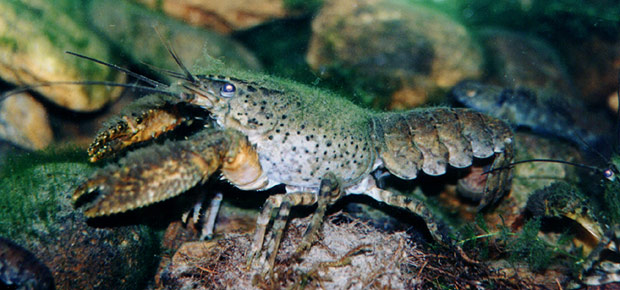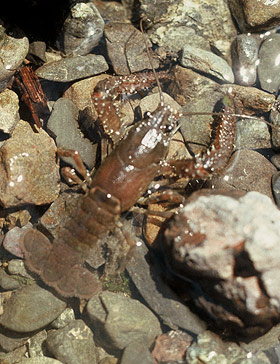|
|
| |
 |
| |
Home > New Zealand ecology > Native freshwater invertebrate list > Koura |
| |
| |
NEW ZEALAND ECOLOGY |
| |
|
|
FRESHWATER INVERTEBRATES |
| |
| |
There are two species of freshwater crayfish in New Zealand. Both are endemic, and of the genus Paranephrops, belonging to the southern hemisphere Parastacidae crayfish family, of the Decapoda order of crustaceans.
Northern koura Paranephrops planifrons, is the smaller of the two species, just 7 cm in length, found throughout the North Island, and Nelson, Marlborough and the west coast of the South Island.
Southern koura Paranephrops zealandicus, is about one centimetre longer than P. planifrons, recognised by more hairy, larger pincers. It is found throughout the east and south of the South Island, and on Stewart Island.
Both are threatened species, with a listing of 'gradual decline' in the 2012 New Zealand Threat Classification System. |
| |
 |
| |
Northern koura Paranephrops planifrons blending with the rock streambed. Photo J. L. Kendrick, Crown Copyright © Department of Conservation |
 |
| |
The Parastacidae family of 14 genera of fresh-water crayfish is distributed throughout the southern hemisphere, in former Gondwana locations, South America, Australia, New Zealand, New Guinea and Madagascar. Extinct taxa have been found in Antarctica.
The lack of species diversity is typical of the New Zealand freshwater fauna. In sharp contrast, on the Australian mainland three genera are endemic with restricted distribution, and another two widespread genera contain about 90 species.
There are two genera in Tasmania, and Chile has three. Madagascar has just one genus as in New Zealand, but five species.
The name Decapoda, the order that incorporates all crustaceans (crayfish, crabs, lobsters, shrimp and prawns), means 'ten footed'. Koura move around on four pairs of legs, while the fifth pair are pincers used for grabbing food, and waiving around in defence. |
| |
|
 |
| |
Above: Southern koura Paranephrops zealandicus with a bluegill bully Gobiomorphus hubbsi in the background.
Photo Stephen Moore, Crown Copyright © Department of Conservation
 Native freshwater invertebrate species list Native freshwater invertebrate species list |
| |
 |
| |
The koura lifecycle .....
Eggs are produced from April until December, but mainly during May and June. The female carries 20 to 200 eggs beneath her abdomen, which is a state called 'in berry'. The hatchlings arrive after 3 or 4 months, looking like a tiny replica of an adult, clinging to their mother until they are about 4 mm long.
Koura are slow growing, with infants taking four years to reach a length of 2 cm when they are first considered adults. Young koura are most vulnerable to predation at such a small size, especially when the shell is still soft.
Koura occupy streams, lakes, ponds and swamps. They are an important part of freshwater ecosystems, as cleansers of the system by scavenging waste on the streambed, and filtering sediment; and as a food source for eels, shags and blue duck. |
| |
 |
| |
Habitat destruction, introduced predators and over-harvesting have caused koura populations to decline |
| |
 |
| |
Northern koura have been found at an elevation of 1246 m in Waimarino Stream on Mt Hauhungatahi in Tongariro National Park.
Koura can bury themselves into mud when ponds or wetlands dry up during a summer drought, and emerge when the water returns with the next rain.
Their presence is most often an indication of clean water. Unfortunately, koura are also a favourite prey of introduced trout which devastate the historic ecosystem in many ways.
Freshwater crayfish have long been a food delicacy for Maori, and are still caught and regarded as a customary food today.
Koura are able to become well camouflaged, matching the color of rocks in the bed, and hiding amongst them and under bank vegetation cover during the day. They are primarily nocturnal, coming out to feed at night.
As the crayfish matures, it outgrows the shell, which must be discarded. There may be up to 9 moults in the first year, reducing to one during the fourth year of life. Koura are more vulnerable to predators while a new shell grows.
Despite koura being threatened, with a 'gradual decline' listing, a permit for recreational fishing is not needed to take koura. Since 1993 there has been a daily maximum combined bag limit of 50 koura per person, under the Fisheries (Amateur Fishing) Regulations 1986.
However, Taupo Fishery Regulations 2004 prohibit any take, possession or sale of the genus Paranephrops (koura), lamprey, eel, or any other indigenous fish except the genus Galaxias. Special provisions allow members of the Tuwharetoa tribe to take koura, koaro or inanga, bullies (toitoi) or freshwater mussels.
There is no commercial catch of koura because no person is permitted to sell or trade koura under the Freshwater Fish Farming Regulations 1983. Permits for commercial koura farming have been issued. Farm raised koura are much larger, reaching 12 to 15 cm in length.
Paranephrops planifrons reared in aquaria at 10°C to 21°C grew to 2 cm in length in 12 to 18 months. P. zealandicus reached the same size in 9 to 10 months, which is faster than in natural populations. With water at 18°C to 21°C, P. planifrons will grow to 3.5 cm in 18 months. |
| |
 |
| |
|
|
The ancient Gondwana ancestry of freshwater invertebrates
New Zealand's freshwater fish and invertebrates provide evidence of ancient ancestry and Gondwana connections more than 80 million years ago.
Research is ongoing to determine distribution of Gondwanan species around southern hemisphere oceans, and whether it was by dispersal following the breakup of Gondwana, or by vicariance within Gondwana through Antarctica before separation of the continents.
Dispersal is the migration of an ancestral population across a pre-formed barrier, such as an ocean.
| |
 |
| |
The linked continents of South America, Antarctica, Australia and New Zealand were an overland dispersal route 130 to 35 million years ago. |
| |
 |
| |
Vicariance is the separation of a population by a barrier, which isolates a new population, and can be the initiation of speciation.
As salt water is poisonous to New Zealand's two freshwater crayfish; insects such as caddisfly, sandfly and mayfly which are food sources within the ecosystem; and mollusks, ocean dispersal does not seem practical.
This community represents the strongest relationship with other Gondwana continents, and supports a previous land connection across Antarctica. Crayfish relatives in the Parastacidae family in Australia and South America are thought to be of Gondwanan origin.
A convincing coincidence is the relationship between flatworms of the genus Temnocephala that attach to the front claws of koura. They only live on a host.
Temnocephala have the same relationship with freshwater crayfish in Australia, and other relatives attach themselves to various hosts, including snails, crayfish and turtles in Brazil, Chile, Argentina, Uruguay, Indonesia and New Guinea.
Evidence of a vicariant origin of the New Zealand freshwater fauna is also provided by a relationship between Galaxiid fish and tiny parasitic larva of the freshwater mussel, genus Hyridella, called a glochidium.
Galaxiid fishes have got a lot of attention in biogeographical research of southern ocean distribution patterns. One indication of Galaxias Gondwanan ancestry is provided by the only two of New Zealand's 17 species that are not endemic.
Inanga G. maculatus is widespread throughout the southern oceans in New Zealand, Tasmania, southeastern and southwestern Australia, South America, and some Pacific Islands. Koaro G. brevipinnis is found in southeastern Australia and Tasmania.
Hyridella larva attach to the gills of Galaxias fishes to obtain nutrients and get a free ride. The minute larval would be washed away in the current without an attachment to the fish.
Coincidentally, the mussel family Hyriidae occurs in New Zealand, South America and Australia in the same habitat with galaxiid fishes.
Separate dispersals of larva and galaxiid fish, and flatworms and koura, and evolution of the same relationships on different continents are unimaginable ecological phenomenon. Vicariant population separation is easier to understand, when associations occurred before Gondwana broke up.
|
| |
 |
| |
|

